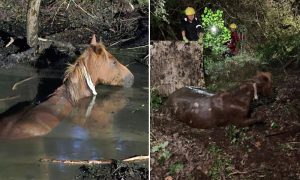Around 30,000 elephants are killed for their tusks by poachers each year. A record 100,000 elephants were killed for their ivory between the years of 2010 and 2012 alone. As international and domestic regulatory measures take aim at the illegal sale of ivory, the now-extinct woolly mammoth poses a new threat to the elephant’s plight.
As climate change melts the Siberian permafrost, newly exposed mammoth tusks are collected and sold legally as a humane alternative. But the ivory industry is using this to mask the illegal sale of elephant ivory. Bearing close resemblance to mammoth ivory, elephant ivory is often marketed as such. Vendors in China will often not distinguish between mammoth or elephant ivory, simply labeling it ivory.
According to the New York Times, China imported more than 27 tons of mammoth ivory in the first six months of 2017, whereas it imported only 4 tons during the same time last year. As long as there is mammoth ivory, there will be ivory laundering and a way to smuggle illegal elephant tusks into the ivory industry.
The domestic and international elephant ivory trade has continued to thrive. In 1989, the Convention on International Trade in Endangered Species of Wild Fauna and Flora (CITES) banned international elephant ivory trade — but it wasn’t a total ban, and there are extensive international trade exemptions.
In an attempt to save elephants from extinction, some countries have taken action, increasing their own restrictions on ivory trade. In 2016, the two largest markets for ivory, the United States and China, made commitments for a near-total ban on domestically bought and sold ivory. At the same time, the United Kingdom withdrew its 2015 pledge of a total ivory ban when Theresa May took office due to the antique industry’s lobbying efforts. A new CITES report reveals that the UK was the biggest exporter of ivory to China and Hong Kong from 2010-2015, providing additional illegal laundering opportunities. Although the United States and China have made progress, it isn’t enough.
As long as there is some legal trade allowed, there are loopholes and smuggling that allow the poaching of elephants to persist. For example, in the United States the federal ban only restricts interstate trade, leaving the sale of ivory within states up to the states’ discretion. One state’s ban leads to a surplus of ivory in another state. In addition to this, a lot of illegal ivory is labeled as antique. Not only are the antique classifications very lenient, antiques are exempt from the interstate ban. These loose regulatory measures perpetuate the illicit trade.
In addition to their sheer beauty and majesty, elephants are an integral part of their environment’s biodiversity. Scientists are now debating the genetically engineered recreation of the woolly mammoth with some DNA of an elephant. The aspiration is admirable: save the permafrost, and stop global warming by recreating the ecosystem to combat it. But it’s hard not to imagine that would just be another animal at risk of eventual extinction and poaching. If we truly cared about the environment we wouldn’t be confronted with the possible destruction of elephants at the hands of human beings that’s already staring us right in the face.






